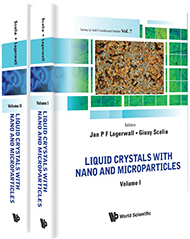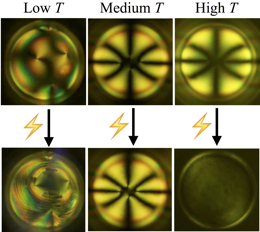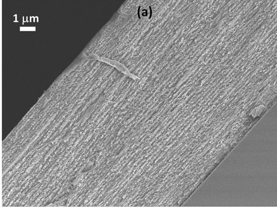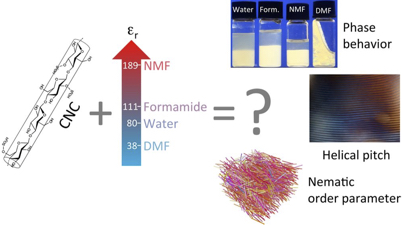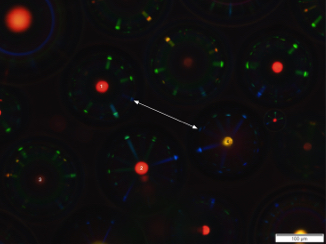2016
New book on Liquid Crystals with Nano and Micro Inclusions
29/12/16 18:50
Finally, it's out! After a long process, sometimes with unexpected turns, the book edited by Giusy Scalia and Jan Lagerwall on nano and micro inclusions in liquid crystals, is now published, printed and available for purchase. "Liquid Crystals with Nano and Microparticles" is published by World Scientific (Singapore) and you can read all about it (and order it, on paper or as an e-book) here. Featuring the world leaders of this broad field and covering a diverse range of aspects, it ended up filling two volumes. The content is as follows (chapter authors in parentheses):
Volume 1:
1. Introduction (G Scalia and J P F Lagerwall)
I. Fundamentals:
2. A Phenomenological Introduction to Liquid Crystals and Colloids (J P F Lagerwall)
3. Nanoparticle Dispersions: A Colloid and Polymer Solution Perspective (P van der Schoot)
4. Nematic Liquid Crystals Doped with Nanoparticles: Phase Behavior and Dielectric Properties (M A Osipov and M V Gorkunov)
II: Methods for Studying Liquid Crystals and Their Inclusions:
5. Conventional and Nonlinear Optical Microscopy of Liquid Crystal Colloids (T Lee and I I Smalyukh)
6. X-Ray Scattering (G Ungar, Z Chen and X Zeng)
7. Raman Spectroscopy (H F Gleeson)
8. Manipulation of Inclusions with Optical Tweezers (M Skarabot)
9. Atomic Force Microscopy on Liquid Crystals (C Bahr and B Schulz)
III. Micron Scale Inclusions in Liquid Crystals:
10. Solid Microparticles in Nematic Liquid Crystals (Igor Muševič)
11. Inclusions in Freely Suspended Smectic Films (R Stannarius and K Harth)
12. Liquid Crystal-Enabled Electrophoresis and Electro-Osmosis (O D Lavrentovich)
Volume 2:
IV. Nanoparticles in Liquid Crystals:
13. Nanoparticles in Discotic Liquid Crystals (S Kumar)
14. Metallic and Semiconducting Nanoparticles in LCs (A Sharma, M Urbanski, T Moria, H-S Kitzerow and T Hegmann)
15. Inorganic Nanotubes and Nanorods in Liquid Crystals (I Drevenšek-Olenik)
16. Liquid Crystals from Mesogens Containing Gold Nanoparticles (W Lewandowski and E Gorecka)
17. Carbon Nanotubes in Thermotropic Low Molar Mass Liquid Crystals (S Schymura, J Park, I Dierking and G Scalia)
18. Carbon Nanotubes Dispersed in Liquid Crystal Elastomers (Y Yang and Y Ji)
19. Ferromagnetic and Ferroelectric Nanoparticles in Liquid Crystals (Y Reznikov, A Glushchenko and Y Garbovskiy)
20. Nanoparticle Guests in Lyotropic Liquid Crystals (S Dölle, J H Park, S Schymura, Hyeran Jo, G Scalia and J P F Lagerwall)
21. Control of Nanoparticle Self-Assemblies Using Distorted Liquid Crystals (E Lacaze and D Coursault)
22. Nanoparticles and Networks Created Within Liquid Crystals (S-W Kang and S Kundu)
Liquid Crystals Formed by Nanoparticle Suspensions:
23. Nematic Phase Formation in Suspensions of Carbon Nanotubes (C Zakri and Ph Poulin)
24. Nematic Phase Formation in Suspensions of Graphene Oxide (N Fresneau and S Campidelli)
25. Electro-Optical Switching of Liquid Crystals of Graphene Oxide (J Song)
26. Liquid Crystalline Phases in Suspensions of Pigments in Non-Polar Solvent (S Klein, R Richardson and A Eremin)
27. Cholesteric Liquid Crystal Formation in Suspensions of Cellulose Nanocrystals (C Honorato-Rios, J Bruckner, C Schütz, S Wagner, Z Tosheva, L Bergström and J P F Lagerwall)
Volume 1:
1. Introduction (G Scalia and J P F Lagerwall)
I. Fundamentals:
2. A Phenomenological Introduction to Liquid Crystals and Colloids (J P F Lagerwall)
3. Nanoparticle Dispersions: A Colloid and Polymer Solution Perspective (P van der Schoot)
4. Nematic Liquid Crystals Doped with Nanoparticles: Phase Behavior and Dielectric Properties (M A Osipov and M V Gorkunov)
II: Methods for Studying Liquid Crystals and Their Inclusions:
5. Conventional and Nonlinear Optical Microscopy of Liquid Crystal Colloids (T Lee and I I Smalyukh)
6. X-Ray Scattering (G Ungar, Z Chen and X Zeng)
7. Raman Spectroscopy (H F Gleeson)
8. Manipulation of Inclusions with Optical Tweezers (M Skarabot)
9. Atomic Force Microscopy on Liquid Crystals (C Bahr and B Schulz)
III. Micron Scale Inclusions in Liquid Crystals:
10. Solid Microparticles in Nematic Liquid Crystals (Igor Muševič)
11. Inclusions in Freely Suspended Smectic Films (R Stannarius and K Harth)
12. Liquid Crystal-Enabled Electrophoresis and Electro-Osmosis (O D Lavrentovich)
Volume 2:
IV. Nanoparticles in Liquid Crystals:
13. Nanoparticles in Discotic Liquid Crystals (S Kumar)
14. Metallic and Semiconducting Nanoparticles in LCs (A Sharma, M Urbanski, T Moria, H-S Kitzerow and T Hegmann)
15. Inorganic Nanotubes and Nanorods in Liquid Crystals (I Drevenšek-Olenik)
16. Liquid Crystals from Mesogens Containing Gold Nanoparticles (W Lewandowski and E Gorecka)
17. Carbon Nanotubes in Thermotropic Low Molar Mass Liquid Crystals (S Schymura, J Park, I Dierking and G Scalia)
18. Carbon Nanotubes Dispersed in Liquid Crystal Elastomers (Y Yang and Y Ji)
19. Ferromagnetic and Ferroelectric Nanoparticles in Liquid Crystals (Y Reznikov, A Glushchenko and Y Garbovskiy)
20. Nanoparticle Guests in Lyotropic Liquid Crystals (S Dölle, J H Park, S Schymura, Hyeran Jo, G Scalia and J P F Lagerwall)
21. Control of Nanoparticle Self-Assemblies Using Distorted Liquid Crystals (E Lacaze and D Coursault)
22. Nanoparticles and Networks Created Within Liquid Crystals (S-W Kang and S Kundu)
Liquid Crystals Formed by Nanoparticle Suspensions:
23. Nematic Phase Formation in Suspensions of Carbon Nanotubes (C Zakri and Ph Poulin)
24. Nematic Phase Formation in Suspensions of Graphene Oxide (N Fresneau and S Campidelli)
25. Electro-Optical Switching of Liquid Crystals of Graphene Oxide (J Song)
26. Liquid Crystalline Phases in Suspensions of Pigments in Non-Polar Solvent (S Klein, R Richardson and A Eremin)
27. Cholesteric Liquid Crystal Formation in Suspensions of Cellulose Nanocrystals (C Honorato-Rios, J Bruckner, C Schütz, S Wagner, Z Tosheva, L Bergström and J P F Lagerwall)
Hakam Agha joins the team
15/12/16 18:54
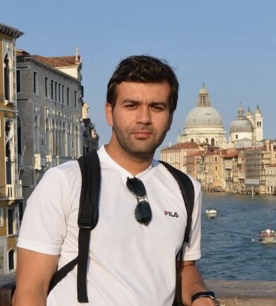
Welcome!!
Dirk Jan Mulder visits the ESMP group
03/11/16 15:12
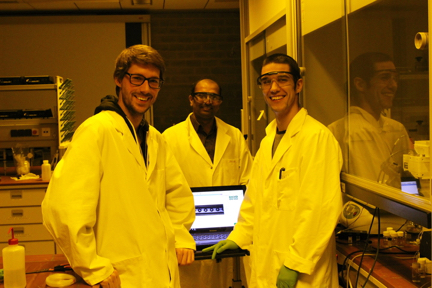
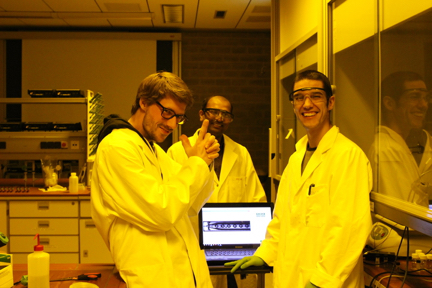
New paper on polymer-stablized liquid crystal shells in Advanced Materials
30/09/16 14:11
Congratulations to JungHyun and Benjamin for their new Adv. Mater. paper "Taming Liquid Crystal Self-Assembly: The Multifaceted Response of Nematic and Smectic Shells to Polymerization" on polymer-stabilization of nematic and smectic liquid crystal shells, and the sometimes unexpected consequences for the liquid crystal self-assembly. By polymerizing a small fraction of the reactive mesogen RM257 in shells of 8CB or its homologues, certain defect configurations can be locked in place, the exact result depending sensitively on the mixture composition and the temperature at which polymerization is carried out. Surprisingly, when polymerizing close to a phase boundary, a transition into the adjacent phase can be induced. The new phase can be more or less ordered, depending on the starting situation. The lifetime of the shells is dramatically enhanced, as is the temperature stability. By tuning the conditions, the self-assembled structure can be made fully permanent, being visible even upon heating to the isotropic phase of the non-polymerized component, or it can be retained in a latent state, allowing macroscopic loss of order on heating to the isotropic phase yet with a memory of the chosen defect configuration when cooling down. Apart from proposing explanations for the various observations we discuss possibilities to apply the polymer-stabilized shells, for instance in advanced materials generation or in sensing.
Here you can find the full paper (don't forget to check out the rich supporting information, including many spectactular movies), and here is a layman's abstract for the paper.
Here you can find the full paper (don't forget to check out the rich supporting information, including many spectactular movies), and here is a layman's abstract for the paper.
New paper on quantitative optical characterization of CNC films
17/09/16 20:29
We have a new article out in the journal Cellulose, describing the results from a collaboration with Sweden and Slovenia. The article, entitled "Correlation between structural properties and iridescent colors of cellulose nanocrystalline films", describes an optical and electron microscopy study of dried films of cellulose nanocrystals (CNC), prepared with or without circular shear flow. This is a follow-up study of our previous study on the influence of shear flow when drying CNC samples to make iridescent films, and the new component is a quantitative spectrophotometric study as a function of location in the films, together with a high-resolution electron microscopy characterization of the fractured films. It turns out that the reflection spectra are surprisingly similar between the two types of films, but the film cross section is very different. Whereas films dried with shear flow have a clearly periodic helical structure throughout the film, the ones dried without shear flow are disordered near the air interface. Because there is still a sufficiently thick internal regime, close to the bottom substrate, that is helical, the reflection spectra are similar, but the structural difference at the film top can have a strong effect on birefringence. The reflection spectra are much broader than what is expected for a cholesteric liquid crystal with well-defined pitch, indicating a variation in pitch within the film, which may be related to the polydispersity of CNC samples.
Read the article on the Cellulose website.
Read the article on the Cellulose website.
New paper in Langmuir on CNC dispersion in non-aqueous polar solvents
17/09/16 20:04
Congratulations to Johanna and co-authors for the publication in Langmuir of the article "Enhancing Self-Assembly in Cellulose Nanocrystal Suspensions Using High-Permittivity Solvents". The team studied dispersion of Cellulose Nanocrystals (CNC) and the associated liquid crystal formation in water and in non-aqueous but polar solvents. Johanna developed a new method for exchanging the solvent of CNC suspensions from the water used during synthesis to formamide, N-methylformamide (NMF) and N,N-dimethylformamide (DMF), without inducing aggregation of the nanorods. She found striking differences between the solvents concerning the liquid crystal formation. The four solvents span a large range of dielectric permittivity, a parameter that turns out to be of key importance. The cholesteric helical superstructure develops much faster in high-permittivity NMF than in water and the pitch depends much less on CNC concentration than when water is the solvent. In low-permittivity DMF the first trace of liquid crystal formation coincides with kinetic arrest of the whole sample, preventing any helix formation since an equilibrium liquid crystal phase never develops. We propose that this is due to aligned aggregation of the CNC nanorods. The experimental results are corroborated by computer simulations done in Tanja Schilling's group, which furthermore indicate that the nematic order parameter goes up for high-permittivity solvents.
If you have an institutional subscription to Langmuir, you can download the article here. If you do not, you can try the following link: http://pubsdc3.acs.org/articlesonrequest/AOR-uVuBGBqpFzkXHmtihG36 . The first 50 to try this link can download the article for free, regardless of subscription.
We regret that the published Acknowledgments section unfortunately did not mention that Rick Dannert is a member of the Laboratory for the Physics of Advanced Materials of the University of Luxembourg and that this group kindly made their equipment (AFM, rheometer and refractometer) available for some of the experiments described in the paper. We deeply apologize for having forgotten this information in the published paper. Here we would like to express our deep gratitude for the support from the Laboratory for the Physics of Advanced Materials.
If you have an institutional subscription to Langmuir, you can download the article here. If you do not, you can try the following link: http://pubsdc3.acs.org/articlesonrequest/AOR-uVuBGBqpFzkXHmtihG36 . The first 50 to try this link can download the article for free, regardless of subscription.
We regret that the published Acknowledgments section unfortunately did not mention that Rick Dannert is a member of the Laboratory for the Physics of Advanced Materials of the University of Luxembourg and that this group kindly made their equipment (AFM, rheometer and refractometer) available for some of the experiments described in the paper. We deeply apologize for having forgotten this information in the published paper. Here we would like to express our deep gratitude for the support from the Laboratory for the Physics of Advanced Materials.
New paper on gas sensing with liquid crystal core microfibers
06/08/16 23:20
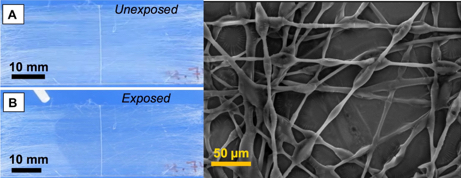
Domenico Alj visits the ESMP group
01/07/16 23:12
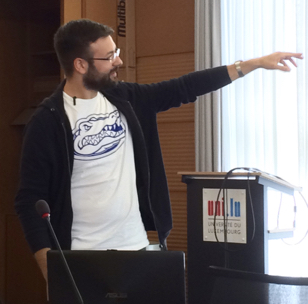
IRES visitors 2016
07/06/16 07:08
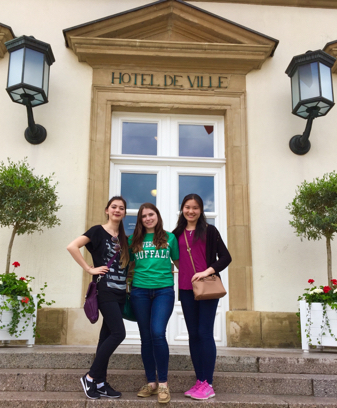
Yong's cholesteric microshells study published in Scientific Reports
30/05/16 10:30
Congrats to Yong on the publication of his cholesteric microshells study in the journal Scientific Reports (Nature Publishing Group)! Together with JungHyun he succeeded in preparing shells from different cholesteric liquid crystal mixtures, giving selective reflection in different color ranges. He has developed a new method to rapidly remove defects by annealing through osmosis, and then he polymerizes a fraction of the mixture that is sufficient to make the shells robust under considerable mechanical deformation. With the help of our collaborators Romano Rupp (University of Vienna) and Irena Drevensek-Olenik (University of Ljubljana) we analyze the complex optics of the photonic cross communication between the shells, finding that the communication is active even between shells with different reflection colors, opening up new communication channels (picture). Finally, our collaborator at the Interdisciplinary Center for Security and Trust (SnT) at the University of Luxembourg, Dr. Gabriele Lenzini, provides a thorough and critical discussion on how the patterns generated by the shells may be used in secure authentication. The paper is Open Access, so please download and read it at http://www.nature.com/articles/srep26840 (and make sure to check the nice movies in the Supporting Information!).
Camila's article on cholesteric-isotropic phase transitions in cellulose nanocrystal suspensions published
03/05/16 08:19
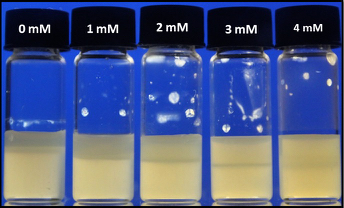
Johanna moves on to a career in industry
05/04/16 00:05

Martin's article on the effect of gold nanoparticle doping on the dielectric properties of nematics on-line
31/03/16 13:52
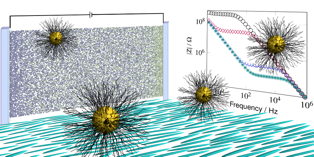
Johanna gets best poster prize at the German-British liquid crystal conference
28/03/16 20:46
Congratulations to Johanna Bruckner, who was awarded the German Liquid Crystal Society's best poster award at the joint conference of the British and German liquid crystal societies, in Edinburgh, UK, 21-23rd of March 2016. The poster, entitled "Solvent effects on chiral nematic self‐assembly of cellulose nanocrystals" (co-authors Camila Honorator-Rios and Jan Lagerwall), describes the behavior of cellulose nanocrystal suspensions in non-aqueous but polar solvents, as well as a new method of exchanging the solvent without inducing aggregation of the rods. A publication is on the way...
JungHyun and Jan represent FSTC in THE advertisement
16/03/16 06:31
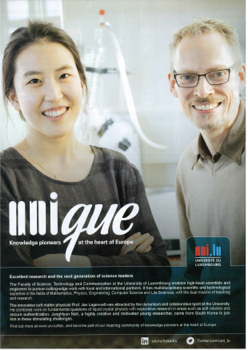
Anshul Sharma joins the ESMP team
18/01/16 10:03








